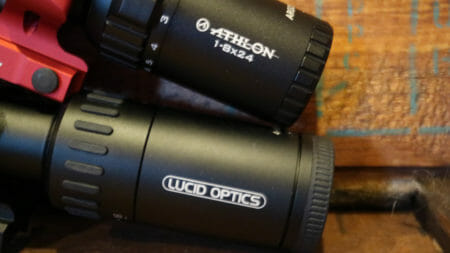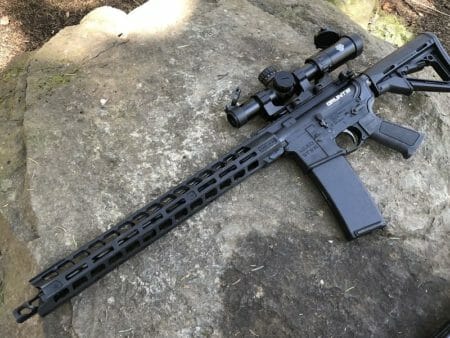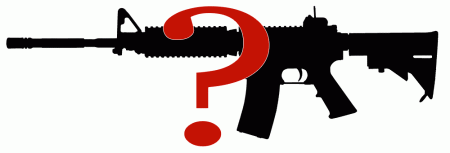
Choosing the right optic for your AR-15 is crucial to maximizing its performance in any shooting scenario. With options like red dots, LPVOs, magnifiers, and scopes, each setup brings unique advantages, but selecting the best fit can be overwhelming.
This guide will break down the pros, cons, and ideal use cases for each optic type, arming you with expert insights to confidently choose the right setup.
Whether you’re looking for quick target acquisition in close quarters or precision at long range, this article will help you make an informed decision tailored to your shooting style and needs.
Understanding Your Optics Options
Before comparing the benefits of each setup, it’s essential to understand what each optic offers and how it’s typically used on an AR-15. Let’s break down the main contenders:
Red Dot Sights
Red dot sights are compact optics that project a dot onto a single plane, allowing for quick target acquisition. Known for their simplicity and ease of use, they are ideal for close-range engagements. Red dots typically offer a wide field of view, making target acquisition quick and easy.
Pros of Red Dots
- Lightweight and compact
- Easy to use, with no magnification to adjust
- Ideal for close-quarters shooting and fast target acquisition
Cons of Red Dots
- Limited to close-range engagements without additional magnification
- May lack versatility for mid-to-long-range shooting
Red Dot with Magnifier
Adding a magnifier behind a red dot sight can extend its effective range, providing a more versatile solution. A flip-to-side magnifier lets you switch between a magnified and unmagnified view, offering flexibility without changing optics.
Pros of Red Dot with Magnifier
- Enhanced versatility with the ability to switch between 1x and magnified views
- Simple, quick adjustments in the field
Cons of Red Dot with Magnifier
- Additional weight and bulk
- Limited magnification (usually around 3x)
- May not be as clear or accurate as a dedicated magnified scope
Low-Power Variable Optics (LPVOs)
Live Inventory Price Checker
Low-Power Variable Optics, or LPVOs, offer a range of magnification, usually between 1x and 6x or 8x, allowing users to toggle between close-range and mid-range distances. LPVOs have become a popular option for AR-15 setups because they combine the benefits of a red dot with a bit of zoom for more distance.
Pros of LPVOs
- Provides a true 1x magnification for close-range engagements
- Offers zoom options for mid-range versatility
- Durable and versatile
Cons of LPVOs
- Heavier and bulkier than red dots and red dots with magnifiers
- Can be pricier depending on quality and magnification range
- Requires some adjustment to quickly switch between zoom levels
Magnified Scopes
Traditional magnified scopes, usually starting at 4x and higher, are suited for long-range shooting and precision. For AR-15 setups, these scopes can be beneficial if you primarily use your rifle for hunting or shooting at extended distances.
Pros of Magnified Scopes
- Ideal for long-range accuracy
- Provides high levels of magnification
- Clearer sight picture at distance
Cons of Magnified Scopes
- Not practical for close-quarters engagements
- Heavier and often more expensive
- Slower target acquisition in fast-paced shooting
Comparing Red Dots, Magnifiers, LPVOs, and Scopes in Real-World Scenarios
Choosing the right optic for your AR-15 setup depends on how you plan to use it. Here’s a breakdown of how red dots, magnifiers, LPVOs, and scopes fare across common shooting scenarios to help you determine the best fit for your needs.
Close-Quarters Combat (CQC) and Home Defense
Speed and accuracy at short distances are crucial for close-quarters engagements or home defense. In these situations, red dot sights truly shine.
- Red Dots: The clear winner here, red dots offer fast target acquisition, making it easy to acquire a sight picture under high-stress conditions quickly. Their wide field of view also enables you to maintain situational awareness, essential in close-quarter scenarios.
- Red Dot with Magnifier: While a magnifier can be added, it’s generally unnecessary for CQC. The added weight and bulk might even hinder performance in confined spaces.
- LPVO: An LPVO with true 1x magnification can work, but due to its slightly larger and more complex design, it may be a bit slower to acquire a target compared to a red dot.
- Magnified Scopes: Magnified scopes are not practical for close-range engagements; they are best suited for precise, long-distance shots and would be too slow for CQC.
Red dots are the optimal choice for close-quarters and home defense setups due to their simplicity and speed.
Mid-Range Versatility (50-200 Yards)
For those who want a versatile AR-15 capable of performing at mid-range distances, a red dot with a magnifier or an LPVO offers the best balance.
- Red Dots: While a red dot can hit targets at 100 yards, target identification can be a challenge beyond this range due to the lack of magnification.
- Red Dot with Magnifier: This combination provides a decent solution for mid-range engagements. The magnifier typically offers 3x magnification, allowing you to see targets at further distances without sacrificing the speed of a red dot for closer encounters.
- LPVO: An LPVO’s 1x to 6x (or 8x) range makes it ideal for mid-range shooting. You can quickly transition from a no-magnification setting for close targets to a higher magnification for further distances, making it one of the most versatile choices for shooters looking to cover both close and mid-range distances.
- Magnified Scopes: While they can reach mid-range distances, magnified scopes lack the flexibility of a red dot or LPVO and are slower for target acquisition at closer ranges.
For mid-range versatility, the red dot with magnifier setup or an LPVO provides the best balance, with the LPVO offering a bit more flexibility.
Long-Range Precision (200+ Yards)
Precision optics are a must if you plan to use your AR-15 for longer-range shooting. Here, magnified scopes and LPVOs are the top choices.
- Red Dots: Red dots are generally unsuitable for long-range precision, as they lack magnification and reticle clarity for pinpoint accuracy at extended distances.
- Red Dot with Magnifier: While adding a magnifier helps, most only offer up to 3x magnification, which falls short for long-range shooting. A 3x magnifier is fine for up to 200 yards, but higher magnification is ideal for more precision.
- LPVO: With a 6x or 8x magnification range, LPVOs offer a more suitable solution for long-range precision. They enable you to engage targets at 200+ yards while providing the option for close-range engagements when needed.
- Magnified Scopes: These are built for precision at a distance. Scopes starting at 4x magnification are ideal for longer shots, providing crystal-clear optics and finer adjustments for accuracy. However, they lack versatility at shorter ranges.
Magnified scopes and LPVOs are ideal for long-range precision. Choose a magnified scope for dedicated long-range shooting or an LPVO if you need versatility for mid-range and longer distances.
My Optic Choices for AR-15 Builds
When setting up my AR-15 builds, I choose optics based on the roles I want them to play. These picks are just what I personally use and love—what works for me might not work for everyone, but if any of these hit the mark for you, then rock on!
Red Dot: Sig Sauer Romeo 5
For a reliable red dot sight, I’ve been using the Sig Sauer Romeo 5. This optic is affordable yet built to take a beating, with a battery life that seems to last forever. For close-quarters shooting, it’s quick, intuitive, and makes target acquisition a breeze.

Holographic Sight: EOTech 512
On one of my AR-15 builds, I run an EOTech 512 holographic sight—a true powerhouse in durability. Known for its near-indestructible build, the EOTech 512 is trusted by military units worldwide, having proven itself in some of the toughest environments imaginable. This optic can handle almost any condition you throw at it, making it a solid choice for those who want a robust, battle-tested sight.

LPVO: Vortex Strike Eagle 1-8×24
Moving into the LPVO category, I highly recommend the Vortex Strike Eagle 1-8×24. With its impressive glass quality and very affordable price, the Strike Eagle is perfect for those who need versatility. It excels in close-quarters scenarios, but the 8x magnification lets you confidently stretch out to a few hundred yards, giving you the best of both worlds.

Magnified Scope: Steiner Predator 4
I’d go with the Steiner Predator 4 for a designated marksman build. This lightweight, rugged scope offers exceptional clarity and an illuminated E3 reticle with windage and BDC holdovers. With 11 brightness settings and excellent low-light performance, this scope adapts to any environment and helps you make precise shots at longer ranges.

Fixed Magnification: Primary Arms SLx 3x Micro Prism
If you want something with more range than a red dot or holographic sight but aren’t looking to dive into variable optics, check out the Primary Arms SLx 3x Micro Prism. This fixed 3-power optic is perfect for target identification up to 200 yards, offering clear and dependable magnification. Its illuminated etched reticle ensures that you’ll still have a reliable sight picture even if the battery dies. Built tough, this compact optic is designed to withstand serious use and might just outlast you in the field.

Each of these optics has its strengths, and for my purposes, they cover all the bases. Whatever setup you choose, make sure it aligns with your needs—and enjoy dialing in your AR-15 for whatever your mission is!
Conclusion
In summary, selecting the right optic for your AR-15 is all about matching your setup to your mission.
A red dot is unbeatable for rapid close-quarters targeting. If you need a balance between close and mid-range, a red dot with a magnifier or an LPVO provides flexibility. For long-range precision, a dedicated magnified scope delivers the accuracy you need.
With the right optic, your AR-15 becomes a more effective, versatile tool, tailored to your needs. Equip yourself with the optic that matches your mission, and confidently hit the range!
About Scott Witner
Scott Witner is a former Marine Corps Infantryman with 2ndBn/8th Marines. He completed training in desert warfare at the Marine Air Ground Combat Center, Mountain Warfare and survival at the Mountain Warfare Training Center, the South Korean Mountain Warfare School in Pohang, and the Jungle Warfare school in the jungles of Okinawa, Japan. He now enjoys recreational shooting, trail running, hiking, functional fitness, and working on his truck. Scott resides in Northeastern Ohio.







For those of us who have an AR15, but have not embellished it with the latest acronyme, we must pause and consider what an LVPO is. I think it is distinqushed from more traditional sights in that it drops to 1X. I also think it always includes a red dot feature. If that is true, then I can now consider it in my rifle build.
HLB
All of our ARs, and one of our defensive shotguns, wear red/green dot or holographic sights. Our bolt actions wear scopes.
You probably don’t want to put a magnifying scope on an AR pistol build since that would lend credibility to the assertion you are really building a SBR. That can get you in trouble with BATFE.
I like both options , I would suggest setting up a rifle with each option . A scoped AR for longer ranges shooting and a red dot for close range low light situations